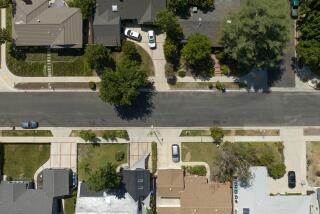NEWS ANALYSIS : Urgent Need to Save Water Evaporates in Drought
In the already parched Owens Valley of the Eastern Sierra Nevada, where Los Angeles traditionally gets the bulk of its water supplies, there has been hardly a drop of rain in the last month.
But somehow, Los Angeles has been brought back from the brink of water rationing.
At a packed news conference a month ago, Mayor Tom Bradley challenged Los Angeles to voluntarily cut water use by 10%, or prepare for imposition of mandatory water rationing within 60 days.
âIf we do not achieve the level of conservation that we need . . . weâre going to have to move immediately for the mandatory program,â Bradley told reporters as he set an April 30 deadline for determining how the community responded to his call for conservation.
But today, when the mayor returns to his City Hall office after a weekâs absence, there will be no decision on the cityâs need for water rationing and there will be no report on the publicâs conservation efforts, city officials say.
Aides to Bradley and officials at the Department of Water and Power now say they do not plan to make any immediate decisions on rationing, but will continue to monitor water supplies, consumption rates and the effects of conservation during the next several weeks.
âWithin the next few weeks we will have to make the decision,â said Mark Fabiani, Bradleyâs chief of staff. âWe have not yet made a complete assessment.â
This softening of Bradleyâs stand is due in part to the DWPâs acknowledged inability to measure water usage quickly, let alone determine how much--if any--increased conservation there has been.
But perhaps more important, some city officials said, the idea of rationing ran into a force more devastating that the four-year drought itself: reality.
Justifying, imposing and enforcing water rationing can take a while, they found.
Some officials said residents need to have an opportunity to cut water use voluntarily, before rationing is implemented.
The city is in the first phase of the emergency water conservation law that encourages voluntary conservation and bans some wasteful water practices, like hosing down sidewalks and driveways. The DWP acknowledges that it has not actively or effectively enforced the law.
On Thursday the DWP commissioners voted to hire squads of âdrought bustersâ to cruise the city and ferret out water wasters. But officials acknowledge that it could take six weeks to two months before the first drought busters hit the streets. Just hiring the water cops, whether it is contracted out to a private company or handled directly by the city, could take six weeks or more, officials said.
A rationing plan could take longer still.
Officials acknowledge that it could take at least one month, and perhaps several, before the city would be able to establish a rationing plan.
âIt depends on how much pressure is exerted,â said Harvey Uribe, assistant director of customer service at the DWP.
In anticipation of a rationing program, the DWP has begun searching for a manager to head an office of emergency conservation, and could make the appointment within a week.
But other aspects of the program could take much longer. It could take weeks to assemble the staff of 20 to 30 workers and get the office space, telephones and computer terminals necessary, Uribe said.
Programming computers to track customer use could take a month or more, Uribe estimated.
At the same time, the City Council would have to adopt, and the mayor sign, a rationing law to replace and one that has been on the books since 1978 and is considered outdated and unworkable by the DWP.
Timing of the program would be critical. To get the most out of the program, rationing would need to be in place during the hot summer months when water use is highest.
But the full impact of the rationing program, which seeks to enforce savings by slapping surcharges on users who consume more than their alloted amount, may not hit until the fall, officials say.
Because of the staggered, two-month billing cycle used by the DWP, many consumers would not have their meters checked for compliance under the law for months after rationing is implemented.
No penalties would be assesed during the first four months of the program, because consumers would be allowed to average their water consumption over several months.
Even if rationing started by June 1, the first penalties would not be assessed until October--well past the peak water demands of summer.
The last time the rationing law was implemented, in 1978, Los Angeles consumers were told to reduce their use of water by 10%, but they cut consumption by an estimated 19%, DWP officials said.
âThe looming penalty is the biggest incentiveâ to cut use, Uribe said.
Still, during the 1978 rationing program, nearly 100,000 users repeatedly violated the law and faced having their water service restricted or shut off.
But before that happened, the rains of winter came, rationing was quickly forgotten and violations were forgiven.
More to Read
Sign up for Essential California
The most important California stories and recommendations in your inbox every morning.
You may occasionally receive promotional content from the Los Angeles Times.










